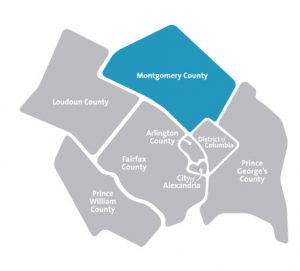Montgomery County consists of a 491 square miles that border Frederick and Howard Counties to the north, Fairfax County to the west, Prince George’s County to the east and Washington DC to the south. With more than 1,000,000 residents, it is the most populous county in Maryland. In 2018, Montgomery County earned the distinction of being named the healthiest county in Maryland by the Robert Wood Johnson County Health Rankings and Community Roadmaps Project.

Montgomery County

According to the U.S. Census Bureau, in 2016 45.9% of its residents identified as White alone, not Hispanic or Latino; 17.3% as Black alone, not Hispanic or Latino; 18.6% as Hispanic or Latino; and 14.5% as Asian. Compared to the state of Maryland, Prince George’s County has twice as many Hispanic and Asian residents, and three-fifths as many black residents. The median household income in 2016 was $99,600, which is significantly higher than the statewide median of $78,800. The unemployment rate of 4.1% is lower than the statewide rate of 4.5%. There are 6.9% of residents living in poverty and 35% of school-age children are eligible for free and reduced meals (FARMS), compared to 9.9% and 45% statewide.
Demographics of Montgomery County vs Maryland
According to the 2018 Community Health Rankings and Roadmaps Project, Montgomery County ranks 1st of 24 Maryland counties based on health factors and outcomes. The life expectancy in Montgomery County is 84.9 years, which is higher than the state life expectancy of 79.7 years. The infant mortality rate in Montgomery County is 5.6 deaths per 1,000 live births; lower than the state rate of 6.5 per 1,000 live births.
Cardiovascular diseases are the leading cause of death among Montgomery County residents. Other health indicators for the county include the percent of adults diagnosed with diabetes at 8%, compared to 10% in Maryland. Finally, the HIV prevalence rate in the County is 425 occurrences per 100,000 people, lower than Maryland’s prevalence rate of 658 per 100,000 people.
Infant Mortality Rates by Race
High Blood Pressure Hospitalization Rate by Race
Heart Disease Hospitalization Rate by Race
Montgomery County has substantial health resources. More than 90% of Montgomery County residents have some type of health care coverage. There are an estimated 1,390 primary care providers practicing in Montgomery County, approximately 1 provider for every 720 residents. In addition, primary care services for low-income and uninsured residents are provided through a network of 12 community-based clinics, including 3 Federally Qualified Health Centers, 1 hospital-based primary care system and several private and faith-based, non-profit clinics. There are 12 School-Based Health and Wellness Centers serving school-age children. The County-funded Montgomery Cares and Care for Kids programs support primary health care services for 30,000 uninsured residents. There are 6 non-profit hospitals located in the County, each associated with regional or national health care systems. Montgomery County is also home to the National Institutes of Health and Mental Health with hospitals and outpatient clinical trials facilities located within its borders.
Making Montgomery County a healthier place for all to live requires not only expanding wellness initiatives and access to quality healthcare, but also addressing the economic and social well-being of its citizens.
To see the data sources used for the information above about Montgomery County, click the purple tab on the right side of this page.




